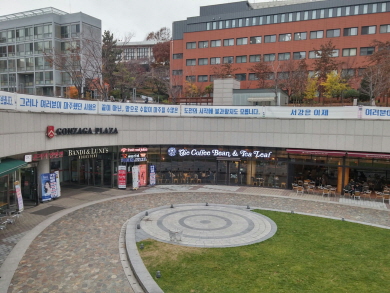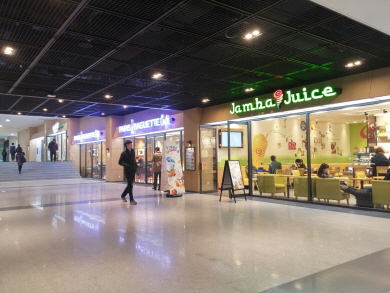


Ivory towers that symbolize university education are increasingly being built below ground levels.
Facing the limitation of ground area on campus, universities are making use of their underground space as well. On Oct. 7, Yonsei University reopened its 550-meter-long main road Baekyangro. The road had undergone a renovation project since August 2013 to make better use of the campus space. The underground space called “The Commons” includes various cultural and academic venues for students’ convenience.
“It became more convenient and safer for students to walk across the campus as the underground parking lot holds many of the cars that previously passed across the campus,” said Jeong So-won, a sophomore at Yonsei University.
As in the case of Yonsei’s “Commons,” several underground campuses in Seoul commonly serve as parking lots, convenience facilities, additional lecture rooms, and cultural venues.
In 2002, Korea University was the first to introduce an underground campus building in Seoul. Central Plaza, a 30,000-square-meter building stretching down to four basement levels, is packed with facilities including cafés, restaurants, auditoriums, and a gym.
“I spend about three hours, three times a week in the Central Plaza. There are several more study rooms on campus, but accessibility leads me to prefer studying in the plaza,” said Lee Seung-heon, a sophomore at Korea University.
To follow up, Ewha introduced its Ewha Campus Complex in 2008; a large-scale underground structure consisting of approximately 66,000 square-meters in total area and a total of six levels below the ground. Accommodating parking lots, restaurants, bookstore, cafés and other convenience facilities, the building also serves as a green campus by surfacing the top of the building with a roof garden.
Completed in August 2008, the Gonzaga Plaza at Sogang University consists of three basement floors and one ground floor. The plaza consists of a food court, fusion restaurants, bookstore, coffee shop, convenience store, and parking facility for 585 cars.
“In addition to saving time by using the short-cut to the main entrance through the building, it is convenient for students not to go off campus to have meals and buy groceries,” said Park Kyoung-jin, a sophomore at Sogang University.
Despite the enhancement of students’ convenience, the expanding movement of underground campus is raising eyebrows among some students, as it tends to attract more commercial facilities and not enough academic and student welfare services.
“Although the underground space enlarged the passages for students and faculty by reducing cars on the grounds, it is not equipped with enough space for students’ team projects or studying,” Jeong remarked. “If the school intended for improvement of students’ campus life, additional consideration should be put on the components packing the underground area.”
Some pointed out that a lot of facilities are highly unrelated to the welfare of students’ campus life due to relatively high prices. Also, some students complained about the stuffiness due to lack of natural light and clean air.
“As it is built underground, there are problems of indoor air quality when the space is fully packed with students,” Lee said. “In particular, there is a study room that accommodates up to 800 students during exam periods, which exacerbates the problem.”
Besides students’ comments on the composition of the underground campus, a recent ruling announced by the Seoul Administrative Court suggests possible restrictions on excessive expansion of commercial facilities on campus.
On Sept. 14, the Seoul Administrative Court announced its ruling against Ewha Womans University, rejecting the school’s demand for property tax exemption amounting to 256 million won. Ewha had filed for an exemption of taxes on the ECC, arguing that the building stands for students’ welfare. However, the court found this request to be invalid as school property that produces rent is subject to taxation by law.
Facing the limited space of ground area, the expansion of underground space seems to be inevitable for universities in Seoul. However, students’ comments and the recent court decision should motivate the universities to prioritize the usage of the facility towards more educational and student welfare purposes.

